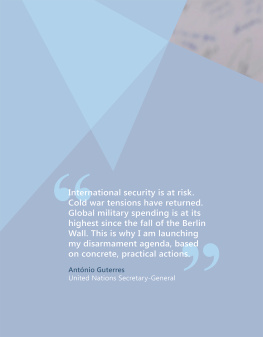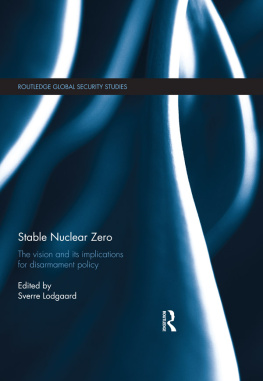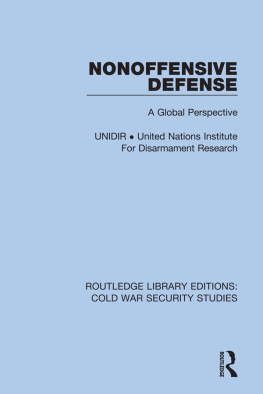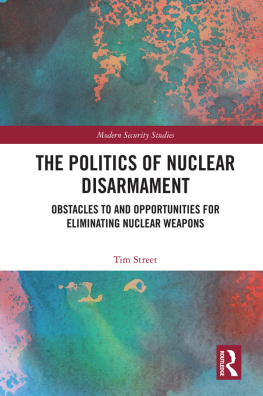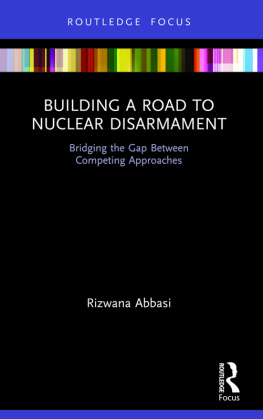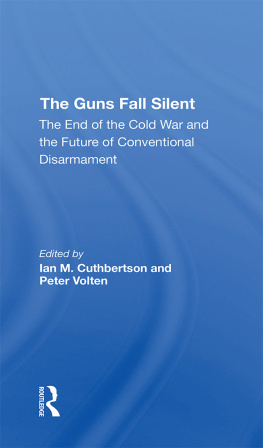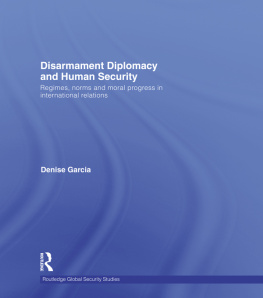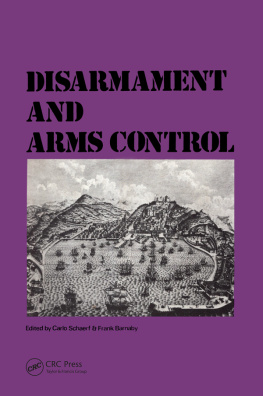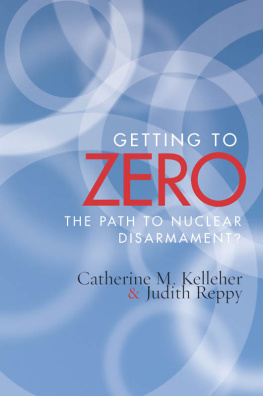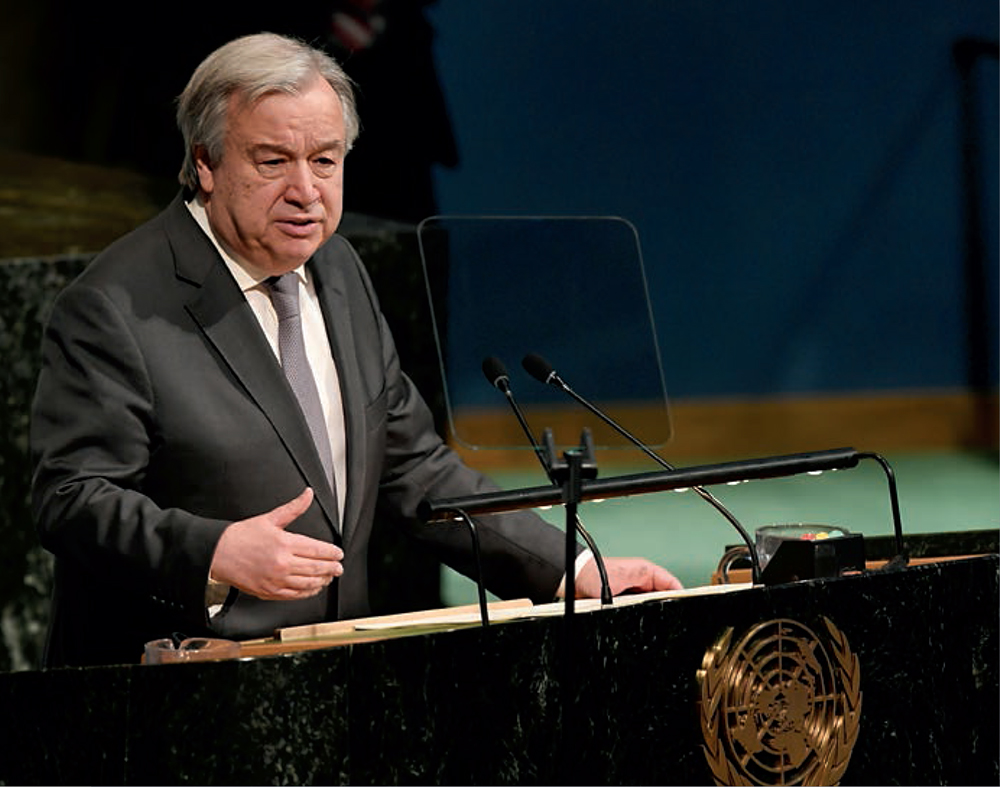The cover depicts Orizuru, an origami paper crane. The Japanese legend has it that, if anyone folds a thousand paper cranes, his or her wish will be granted by the gods. Sadako Sasaki was two years old when an atomic bomb fell on Hiroshima in 1945. She was caught in black rain and developed leukaemia 10 years later. At her hospital bed, Sadako was folding over a thousand cranes, praying for her recovery. She died at the age of 12, but her story of folding thousands of cranes spread around the world. Origami cranes have become symbols of peace. The paper crane on the cover was attached to a peace tapestry created by students and teachers from Nutley High School in New Jersey, United States of America, who came to the United Nations Headquarters in observance of United Nations Day on 24 October 2017.
Photo credits:
Cover: UN Photo/Cia Park
Foreword: UN Photo/Evan Schneider
SECURING OUR COMMON FUTURE
An Agenda for Disarmament
Office for Disarmament Affairs
New York, 2018
Electronically available in PDF and e-book formats from
www.un.org/disarmament/sg-agenda
United Nations Publication
Sales No. E.18.IX.6
ISBN 978-92-1-142329-7
eISBN 978-92-1-047209-8
Copyright 2018 United Nations
All rights reserved worldwide
Printed in the United States of America
Contents
List of boxes
List of figures
List of tables
W e are living in dangerous times. Protracted conflicts are causing unspeakable human suffering. Armed groups are proliferating, equipped with a vast array of weapons. Global military spending and competition in arms are increasing, and the tensions of the cold war have returned to a world that has grown more complex. In todays multipolar environment, the mechanisms for contact and dialogue that once helped to defuse tensions between two super-powers have eroded and lost their relevance.
This new reality demands that disarmament and non-proliferation are put at the centre of the work of the United Nations. This is the backdrop for my agenda for disarmament.
Throughout history, countries have pursued disarmament to build a safer, more secure world and to protect people from harm. Since the foundation of the United Nations, disarmament and arms control have played a critical role in preventing and ending crises and armed conflict. Heightened tensions and dangers can only be resolved through serious political dialogue and negotiationnever by more arms. Disarmament and arms control measures can help ensure national and human security in the 21st Century, and must be an integral part of our collective security system.
The existential threat that nuclear weapons pose to humanity must motivate us to accomplish new and decisive action leading to their total elimination. We owe this to the Hibakushathe survivors of nuclear warand to our planet.
We must also increase efforts to prevent and reverse the over-accumulation of all other types of arms. We must put people at the centre of our disarmament efforts, and ensure disarmament that saves lives today and tomorrow. We owe this to the millions of people killed, injured and uprooted from their homes, in the Syrian Arab Republic, Yemen, Afghanistan, South Sudan, Somalia, Mali and elsewhere.
We must also work together to make sure that developments in science and technology are used for the good of humankind. Our joint efforts to prevent the weaponization of new technologies will save future generations. We owe this to our children and grandchildren.
My agenda for disarmament aims to be comprehensive, but not exhaustive. It proposes solutions, and it raises questions. It is not intended to replace the responsibilities of Member States, nor is it meant to impose any specific measures on them. My hope is that this agenda will reinvigorate dialogue and negotiations on international disarmament, stimulate new ideas and create new momentum.
My agenda also integrates disarmament into the priorities of the whole United Nations system, laying the foundations for new partnerships and greater collaboration between different parts of our organization and Governments, civil society, the private sector and others. It focuses on practical measures and indicates where I intend personally to engage and support Member States in carrying out their responsibilities.
Many Member States, independent experts and members of civil society have contributed to developing this agenda. I thank them sincerely for their engagement and support.
There are moments in history when individual and collective courage and conscience come together to change the course of events. I hope this disarmament agenda will help set our world on a path towards sustainable peace and security for all.
Antnio Guterres
United Nations Secretary-General
24 May 2018
Executive summary
THE NEED FOR A NEW DISARMAMENT AGENDA
C old war tensions have returned, but in a much more complex and dangerous environment. Armed conflicts have become more frequent, longer and more devastating for civilians. Civil wars are interconnected with regional and global rivalries. They involve many actors, such as violent extremists, terrorists, organized militias and criminal elements, equipped with various types of weapons. Governance of the international system has also grown more complex, with a growing multiplicity of interests that are challenging consensus-based disarmament processes.
The costs of the resulting insecurity are enormous, with more than one eighth of the worlds gross product spent in 2017 on containing all forms of violence and with global military expenditures at its highest level since the fall of the Berlin Wall. New weapon technologies are increasing risks, including from the ability of non-State actors to carry out attacks across international boundaries. In many recent conflicts, the laws of humanity have been disregarded and prohibited weapons, such as chemical munitions, have returned to the battlefield. Conventional explosives are being used in cities with devastating impacts on civilians and their surroundings.
Many of the disarmament commitments and promises entered into at the end of the cold war have gone unfulfilled, including practical steps to reduce dangers, ease international tensions, and ultimately bring us closer to a safer and more secure world. The pursuit of disarmament is therefore even more essential in a time of heightened international tensions and conflict.
Disarmament is a tool to help prevent armed conflict and to mitigate its impacts when it occurs. Measures for disarmament are pursued for many reasons, including to maintain international peace and security, uphold the principles of humanity, protect civilians, promote sustainable development, and prevent and end armed conflict. Just as the notion of security has evolved to place humans at the centre, the objectives and language of disarmament need to evolve in order to contribute to human, national and collective security in the 21st Century.
This non-paper outlines a set of practical measures across the entire range of disarmament issues, including weapons of mass destruction, conventional arms and future weapon technologies. It seeks to generate fresh perspectives and to explore areas where serious dialogue is required to bring disarmament back to the heart of our common efforts for peace and security.

